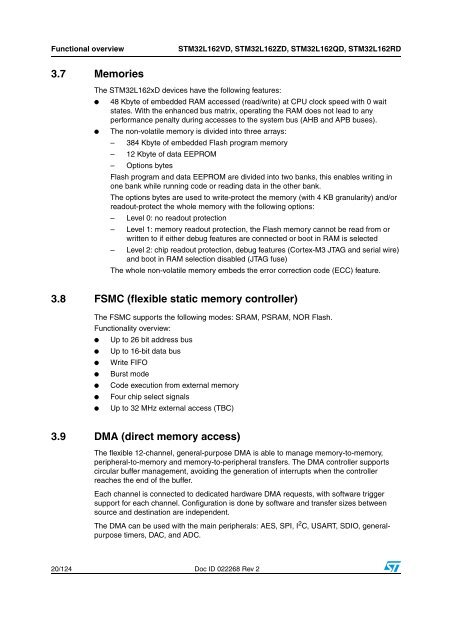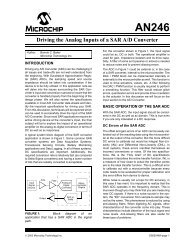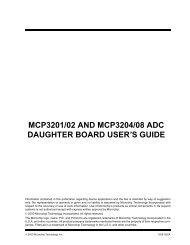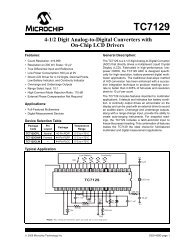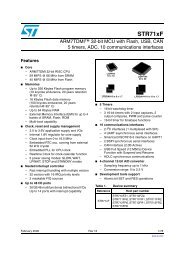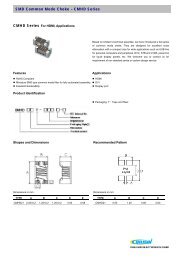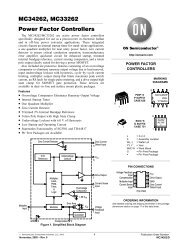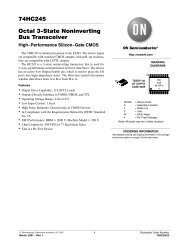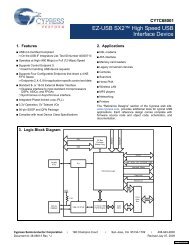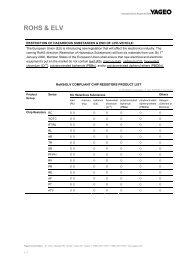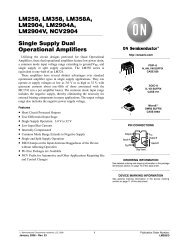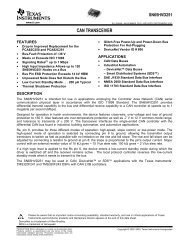Ultralow power ARM-based 32-bit MCU with 384 Kbytes Flash ... - Keil
Ultralow power ARM-based 32-bit MCU with 384 Kbytes Flash ... - Keil
Ultralow power ARM-based 32-bit MCU with 384 Kbytes Flash ... - Keil
- No tags were found...
You also want an ePaper? Increase the reach of your titles
YUMPU automatically turns print PDFs into web optimized ePapers that Google loves.
Functional overviewSTM<strong>32</strong>L162VD, STM<strong>32</strong>L162ZD, STM<strong>32</strong>L162QD, STM<strong>32</strong>L162RD3.7 MemoriesThe STM<strong>32</strong>L162xD devices have the following features:●●48 Kbyte of embedded RAM accessed (read/write) at CPU clock speed <strong>with</strong> 0 waitstates. With the enhanced bus matrix, operating the RAM does not lead to anyperformance penalty during accesses to the system bus (AHB and APB buses).The non-volatile memory is divided into three arrays:– <strong>384</strong> Kbyte of embedded <strong>Flash</strong> program memory– 12 Kbyte of data EEPROM– Options bytes<strong>Flash</strong> program and data EEPROM are divided into two banks, this enables writing inone bank while running code or reading data in the other bank.The options bytes are used to write-protect the memory (<strong>with</strong> 4 KB granularity) and/orreadout-protect the whole memory <strong>with</strong> the following options:– Level 0: no readout protection– Level 1: memory readout protection, the <strong>Flash</strong> memory cannot be read from orwritten to if either debug features are connected or boot in RAM is selected– Level 2: chip readout protection, debug features (Cortex-M3 JTAG and serial wire)and boot in RAM selection disabled (JTAG fuse)The whole non-volatile memory embeds the error correction code (ECC) feature.3.8 FSMC (flexible static memory controller)The FSMC supports the following modes: SRAM, PSRAM, NOR <strong>Flash</strong>.Functionality overview:● Up to 26 <strong>bit</strong> address bus● Up to 16-<strong>bit</strong> data bus● Write FIFO● Burst mode● Code execution from external memory● Four chip select signals● Up to <strong>32</strong> MHz external access (TBC)3.9 DMA (direct memory access)The flexible 12-channel, general-purpose DMA is able to manage memory-to-memory,peripheral-to-memory and memory-to-peripheral transfers. The DMA controller supportscircular buffer management, avoiding the generation of interrupts when the controllerreaches the end of the buffer.Each channel is connected to dedicated hardware DMA requests, <strong>with</strong> software triggersupport for each channel. Configuration is done by software and transfer sizes betweensource and destination are independent.The DMA can be used <strong>with</strong> the main peripherals: AES, SPI, I 2 C, USART, SDIO, generalpurposetimers, DAC, and ADC.20/124 Doc ID 022268 Rev 2


